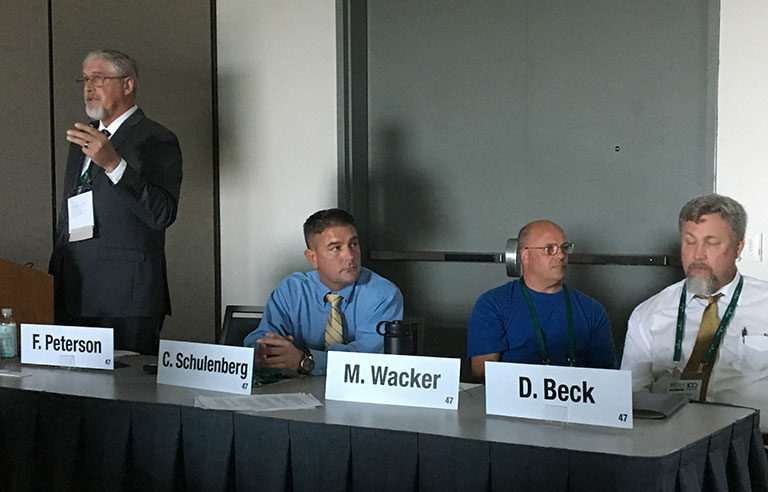OSHA inspectors present ‘Most Interesting’ cases during NSC Congress & Expo session

San Diego — The cases of a worker being killed and another suffering serious injuries while painting a mural on the side of high-rise building, an apprentice suffering injuries while working near power lines, a fatal trench collapse that resulted in another worker being injured, and an abrasive blasting incident in which a worker was fatally blasted with a hose were discussed Monday during OSHA’s “Most Interesting” Technical Session at the National Safety Council 2019 Congress & Expo.
For the pair of workers painting a mural on the side of a newly renovated high-rise building in Florida, it wasn’t the usual situation of construction workers using scaffolding, said Chad Schulenberg, a compliance safety and health officer from OSHA’s Fort Lauderdale (FL) office. The failure of an onsite contractor to protect their safety, he said, contributed to a scaffolding collapse that caused one worker’s death and the other to suffer serious injuries from a 40-foot fall.
The workers were using scaffolding borrowed from another contractor who was doing stucco work at the same time. Schulenberg said the contractor involved ran out of anchors to secure the scaffolding and decided to get more from another source rather than the rental company from which the scaffolding came.
The drop-in anchors were then installed with 5/8-inch eyebolts that were not flush with the surface, causing the eyebolts to fail when they were installed at an 83-degree angle, instead of vertically, into the concrete. The platform, the two workers and their equipment weighed about 1,400 pounds, exceeding the working load capacity of the eyebolts.
The employer was cited for not having a competent person inspect the scaffolding and its components and overloading the scaffolding, leading to its failure.
“This was the most complex fatality that I’ve investigated,” Schulenberg said. “It shows how small things can lead to big things.”
Electrical safety incident in Colorado
A 22-year-old apprentice sustained severe injuries while working near power lines in Colorado. Each line carried 320 kilovolts, making the area extremely dangerous for workers, who noted safety issues before the incident.
Fred Peterson, a compliance investigator from OSHA’s Englewood (CO) Area Office, said the employer discouraged feedback on hazardous conditions, focused only on getting the work done quickly and left key details out of various site inspection documents. One worker, in fact, was so concerned about the hazards on the jobsite that he took cellphone video of flames coming from the bottom of the wooden power poles because the lines weren’t properly grounded. In addition, Peterson said, a 6-foot plasma arc occurred when tools came in contact with the power lines, which were supposed to be deenergized during the work.
“This made my investigation pretty easy,” Peterson said.
The apprentice was injured while atop a pole to install a grounding bar.
Peterson said he spent 84 days inspecting hundreds of documents, and work on the job was halted for a year until the employer abated the hazards. The contractor also paid $1 million for an engineering study of the area.
The safety inspection documents from the employer, however, noted only one tear in a flame-resistant shirt and a few improper personal protective equipment mentions.
The employer was cited for violating OSHA standards 1926.962(c) and 1926(d).
Trench collapse in Texas
A worker was fatally injured and another suffered back and leg injuries in a trench collapse in Lockhart, TX. Darren Beck, a safety compliance officer from the OSHA Austin (TX) Area Office, said the employer involved not only didn’t use a trench box, but also used only 6 feet of hydraulic shoring in two areas of the 12-foot trench, which were inadequately protecting the workers.
“If you ever drive past a trench and you don’t see the shoring but you see guys in there and it’s 5 feet deep, call OSHA,” Beck said.
Abrasive blasting incident
Industrial hygienist Mike Wacker, from OSHA’s Madison (WI) Area Office, shared the story of a worker fatally injuring himself doing abrasive blasting. The worker, on his first day on the job, blasted himself with a hose that sprayed sand at 125 pounds per square inch. The employer received 13 citations, including four each for Grade D breathing air and abrasive blasting booth inadequacies.

